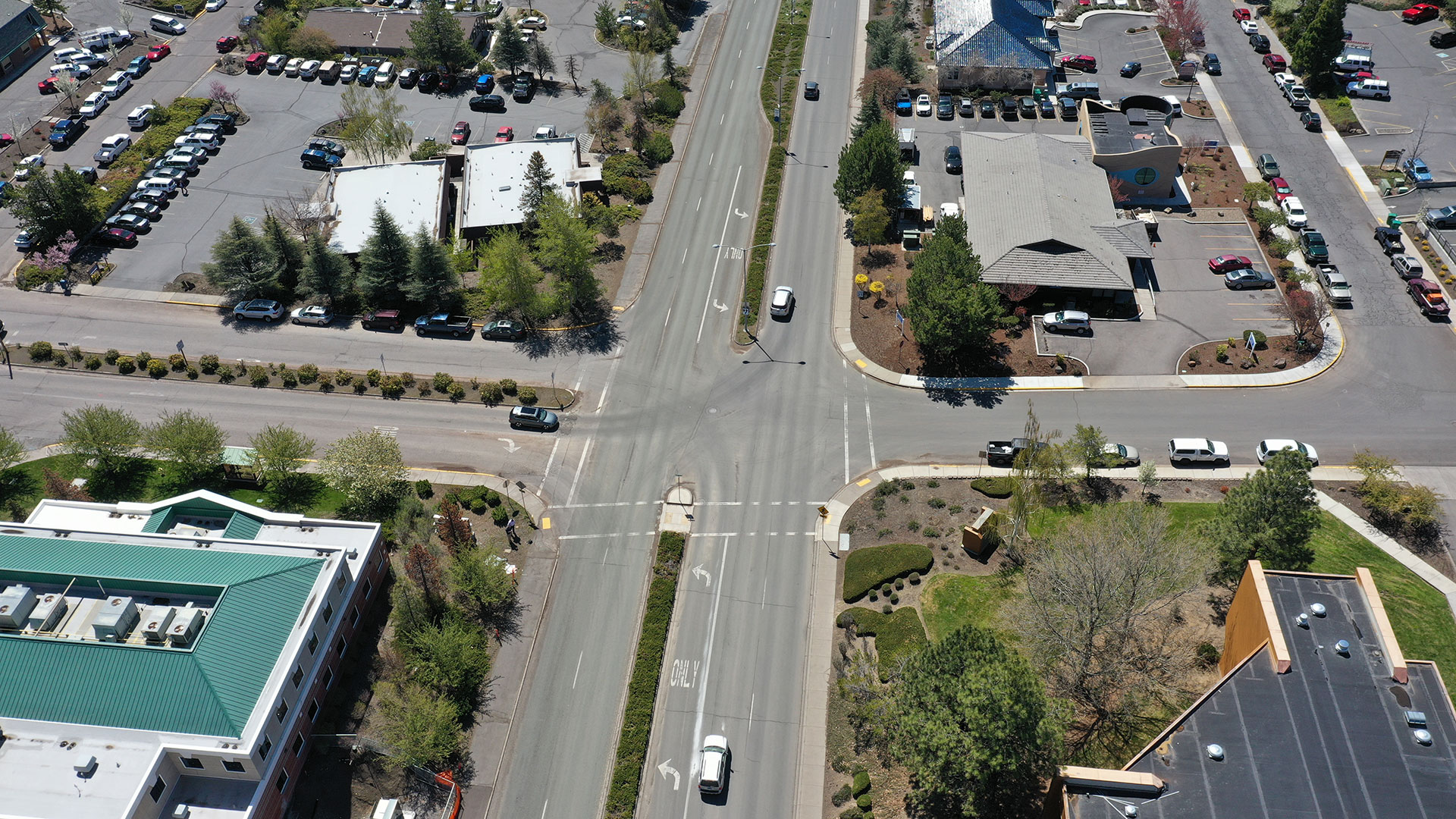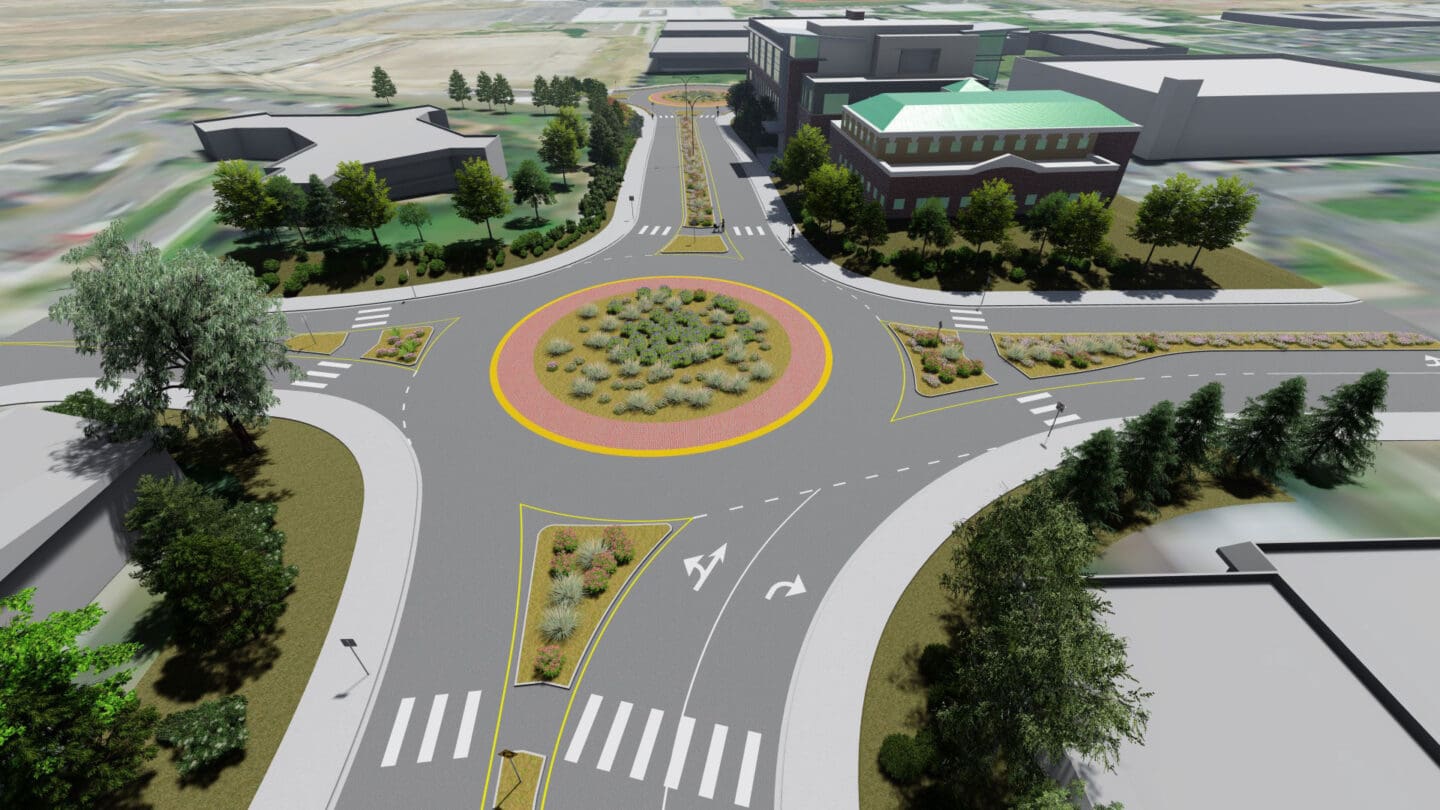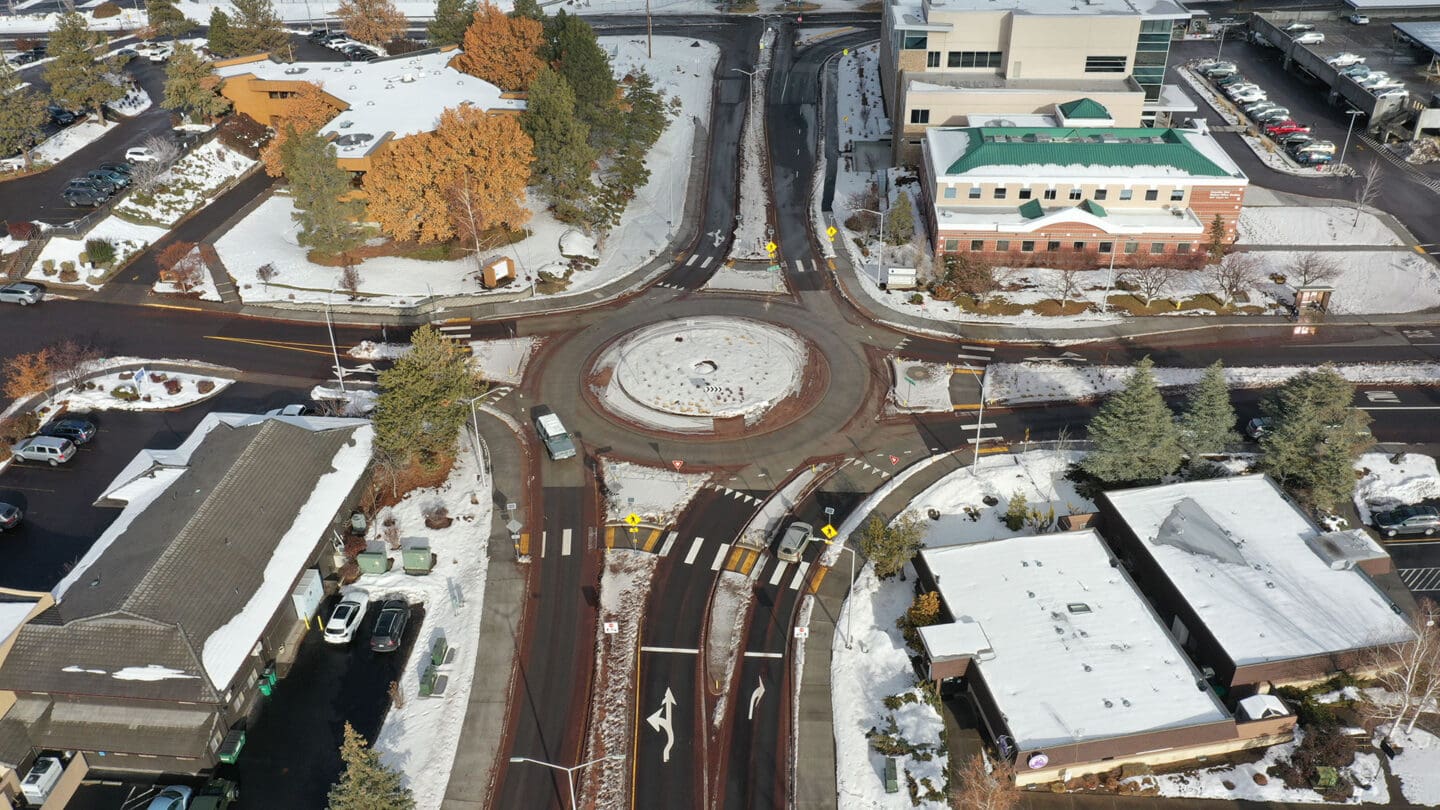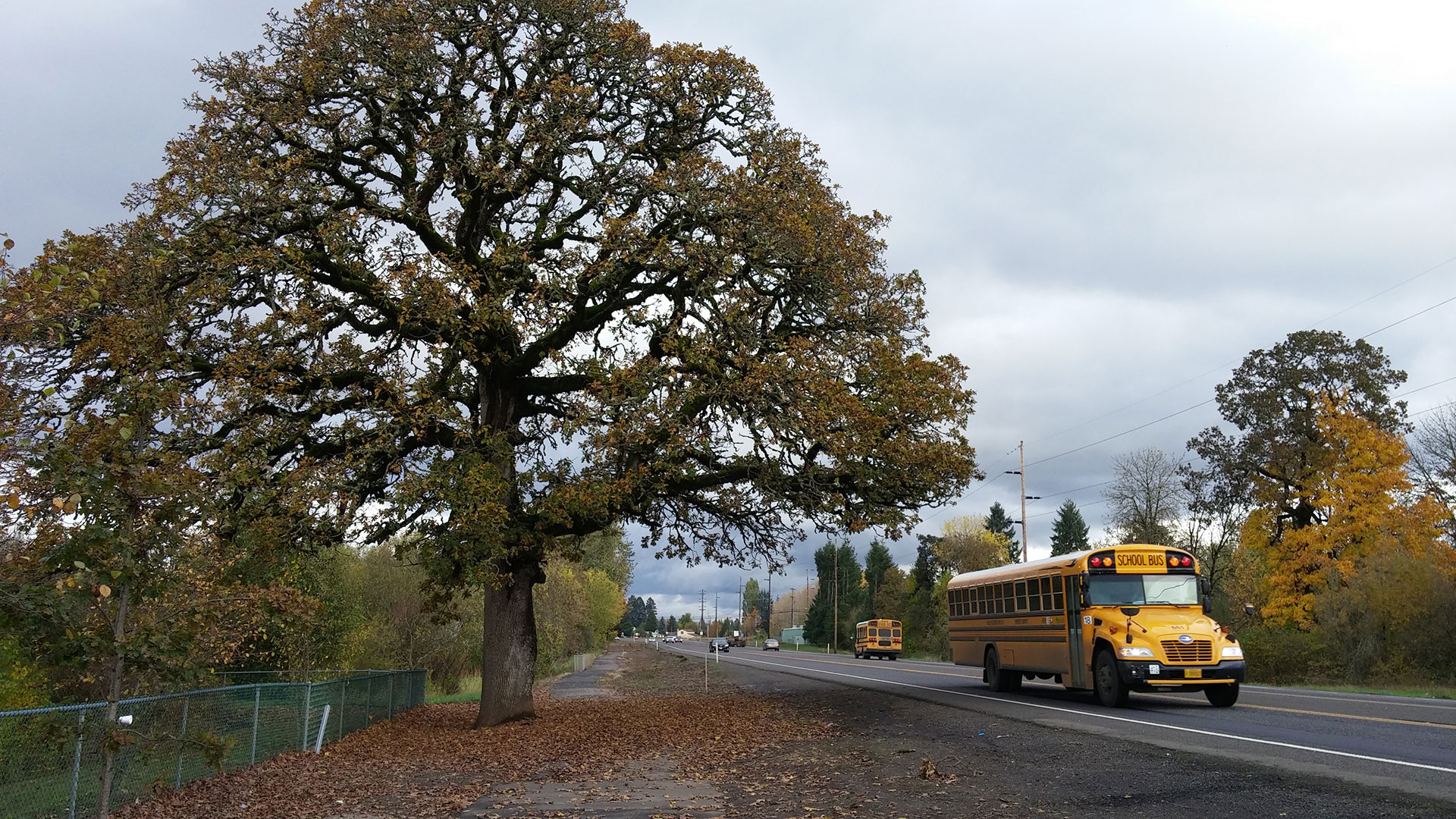April 12, 2024
Campus Drive in Klamath Falls is an important corridor in the Klamath Falls community, providing access to a variety of retail services and connecting the community to the Sky Lakes Medical Center and Oregon Tech campuses. Several years before this story begins, Matt Kittelson remembers standing at the stop-controlled intersection of Campus Drive and Daggett Avenue contemplating a better design solution for the busy intersection.
In 2017, Matt found himself addressing that question again when he got the opportunity to lead a transportation impact assessment (TIA) for the expansion of Sky Lanes Medical Center, immediately adjacent to the intersection. The TIA called for improvements at the Campus/Daggett intersection to mitigate the added demand brought by the new development. Adding a signal seemed like the obvious choice, but Matt and his team wanted to investigate all options on the table.

The formerly stop-controlled intersection of Campus Drive and Daggett Avenue in Klamath Falls, Oregon.
They brought together bright minds from across the City of Klamath Falls, Klamath County, and Sky Lakes Medical Center to consider the problem and potential solutions. This led to concept evaluations of intersection forms that included signals but also included one unique idea: design and implement the City’s first roundabout.
At first glance, the roundabout concept didn’t seem feasible. This intersection was in a unique position at the valley of Daggett Avenue and crest of Campus Drive. It was also assumed that a right turn lane would be needed for emergency access to the hospital. At the concept level, the roundabout would likely have fallen to the bottom of the list if it weren’t for the early involvement of Principal Engineer Tony Roos, who led a team of design engineers through an analysis that concluded a roundabout was actually feasible for this intersection, and would bring many benefits, including better safety performance and compatibility with adjacent land uses. By the time the concept work was done, everyone knew exactly what the roundabout would look like and how it would work.
With a clear understanding of the project’s feasibility, the City of Klamath Falls advanced the roundabout concept, accounting for the added cost by receiving Congestion Mitigation and Air Quality Improvement (CMAQ) funding for which the roundabout qualified. With Matt’s continued involvement, Tony took the project through final design, and it was constructed in 2022. This is how the first roundabout on the City of Klamath Falls transportation system came to be.

A rendering of the proposed roundabout design.

The completed roundabout, which was constructed in 2022.
Why tell this story? Because it illustrates a principle we think is integral to every project’s success: the collaboration of disciplines (research, planning, operations, design) at all stages. Planners making decisions without designers in the room will not have a complete picture of the design feasibility of concepts. Designers taking on projects without the involvement of planners or the original project managers will not have a complete picture of the project’s intent.
The process doesn’t have to look the same way for every company or project, but we think it’s crucial that it happens. After all, research and planning are tasked with guiding something to ultimately being built; and design and construction is about bringing to life something that was driven by an important need and process.
Planning Documents Shouldn’t Collect Dust
If you work on the planning side of the profession, hopefully you’ve had the experience of seeing one of your planned projects come to life through being designed and constructed—the culmination of weeks, months, maybe years of hard work. Unfortunately, many planned projects don’t make it to this stage. There are a variety of legitimate reasons why; mostly notably because projects need to be funded amidst a host of competing priorities. But the better you can link planning and design, the better chance you’re giving projects of making their way to implementation through creating better concepts and developing an accurate understanding of feasibility.
This is effective in shorter turnaround projects, too, like new developments. For example, we’re working on a proposed mixed-use development north of Orlando that will, if built, be situated near a congested county road. At the same time that Kok Wan Mah is leading a TIA for the project, Brandon Kelley is beginning to work on transportation design elements that will mitigate project impacts. Once the traffic study is complete, Kok Wan will stay involved through the finalization of design plans. Through this process, our design team is identifying mitigations that are fine tuned to the developer’s vision.
Designers Should Know the “Why” Behind Projects
As mentioned above, this blending of disciplines brings tremendous benefits during the design stage as well. When planners stay involved in an advisory capacity, design engineers aren’t working based on a giant game of telephone. And when designers pair with researchers, they can incorporate new guidance rather than just doing things the way they were done before.
One example of this is road safety audits (RSAs), in which corridors experiencing safety issues are examined over an intensive multi-day assessment. If an RSA advances to specific projects being funded and designed, it can be common practice for the design to be developed by an entirely separate team than the team that conducted the audit—but this can lead to inconsistencies or gaps in understanding.
In 2012, Hermanus Steyn led an RSA for three miles of state highway outside of Forest Grove, Oregon. City, county, and state representatives and consultants all came together to conduct the assessment and generate a report. They flagged one intersection in particular, and the recommendation was confirmed when tragically, someone was hit and killed on a motorcycle at that intersection shortly after the RSA was completed.

If an RSA advances to specific projects being funded and designed, it can be common practice for the design to be developed by an entirely separate team than the team that conducted the audit—but this can lead to inconsistencies or gaps in understanding.
When the project moved into concept design, our team had the opportunity to stay involved through leading the intersection control evaluation (ICE) process, through which we evaluated a J-hook, signal, and roundabout. In working through ICE for this project, we were not only able to implement best practices from the new national ICE guide through consulting our Kittelson colleagues who led that research, but we also had the benefit of Hermanus’ input drawing from the previous project stages. The signal concept was advanced and Hermanus’ understanding of the roadway context helped us identify speed management techniques, including extended curbs and median islands, to create a self-enforcing roadway. The project just received funding to be constructed in 2025.
Two Practical Ways to Work with a “Concept to Completion” Mindset
These ideas can be summed up in two practical principles that we think are relevant to anyone who works on a project that begins in the research and planning stages and makes its way through the cycle to be funded, designed, and implemented.
1. Don’t pass the baton. It’s tempting to think about the project lifecycle as a relay race: one person completes their part and hands the project off to the next person. This might be a great way to win a race, but it’s a challenging way to get a project done. A handoff implies that someone is stepping out, meaning that whoever grabbed the baton is now steering the ship without the same nuanced understanding of what’s driving the project.
2. Introduce designers in the planning stages, and retain planners in the design stages. At Kittelson, when we have the opportunity to take a project all the way from planning through final design, we think of these phases more like changes in focus. When it’s time to jump into design, we’ll lean on someone with technical design expertise to lead that phase, but will retain whoever managed the project in the planning stages to weigh in at key points and keep the bigger picture of “why” at the forefront of the effort until the final design plan is approved. Conversely, we’ll bring in design experts in the planning and conceptual stages so that we can recommend concepts that best meet the needs and constraints of each project site. Ultimately, the team crosses the finish line together.
These principles benefit projects through bringing cohesiveness and consistency and keeping important information from being lost in translation; and they benefit project teams because everyone learns from one another. The adage “if you want to go fast, go alone; if you want to go far, go together” is true for a successful project.

The blending of disciplines brings tremendous benefits in all project stages.
What Does It Mean to Be Multidisciplinary?
If you can’t tell, we get excited about the power of learning from one another throughout all stages of a project. In addition to the benefits to projects—making plans more feasible, keeping designs true to the original project intent, and maintaining a consistent vision throughout a project—this way of operating makes for well-rounded professionals.
No matter what your focus is within the profession, it’s valuable to understand what is considered in the other project stages. We should be planning for operations and designing with a strong grasp of research. One way we do this at Kittelson is by having all entry-level engineers and planners begin as transportation analysts who work on a broad range of projects. This helps them hone their interests or, even if they already know where they want to focus, learn how they can pull other experts into their projects when they become project managers.
We think this is where the true value of being a multidisciplinary firm lies: silo-free collaboration among researchers, planners, and engineers. When helping communities make difficult decisions about tradeoffs, we have direct access to Conor Semler, Meredyth Sanders, and the team that developed the cross-section guide. When working on a roundabout design, we can call on Julia Knudsen, who managed the new roundabout guide’s development, or Lee Rodegerdts, who served as a Principal Investigator on the project. Our planners are bringing in designers, and design engineers are checking back with planners. It is through this open, collaborative environment that our clients get the full benefit of a full-service team, and it makes us all better in the process.
What Could This Look Like in Your Organization?
As we mentioned earlier, there is more than one way that disciplines can be integrated to reach a successful outcome, and we’re not suggesting everyone needs to follow our approach. If we could highlight one thing in conclusion, it’s the importance of having everyone in the room.
Whatever your process looks like for fostering a two-way exchange of ideas and input as projects travel through their lifecycles, the outcomes will be strongest when experts from every discipline are hearing from one another—and crossing the finish line together. It’s a sure way to get disqualified from a relay race, but it’s the best way we know to deliver a successful project. Communities are best served when we can bring ideas all the way from concept to completion.
